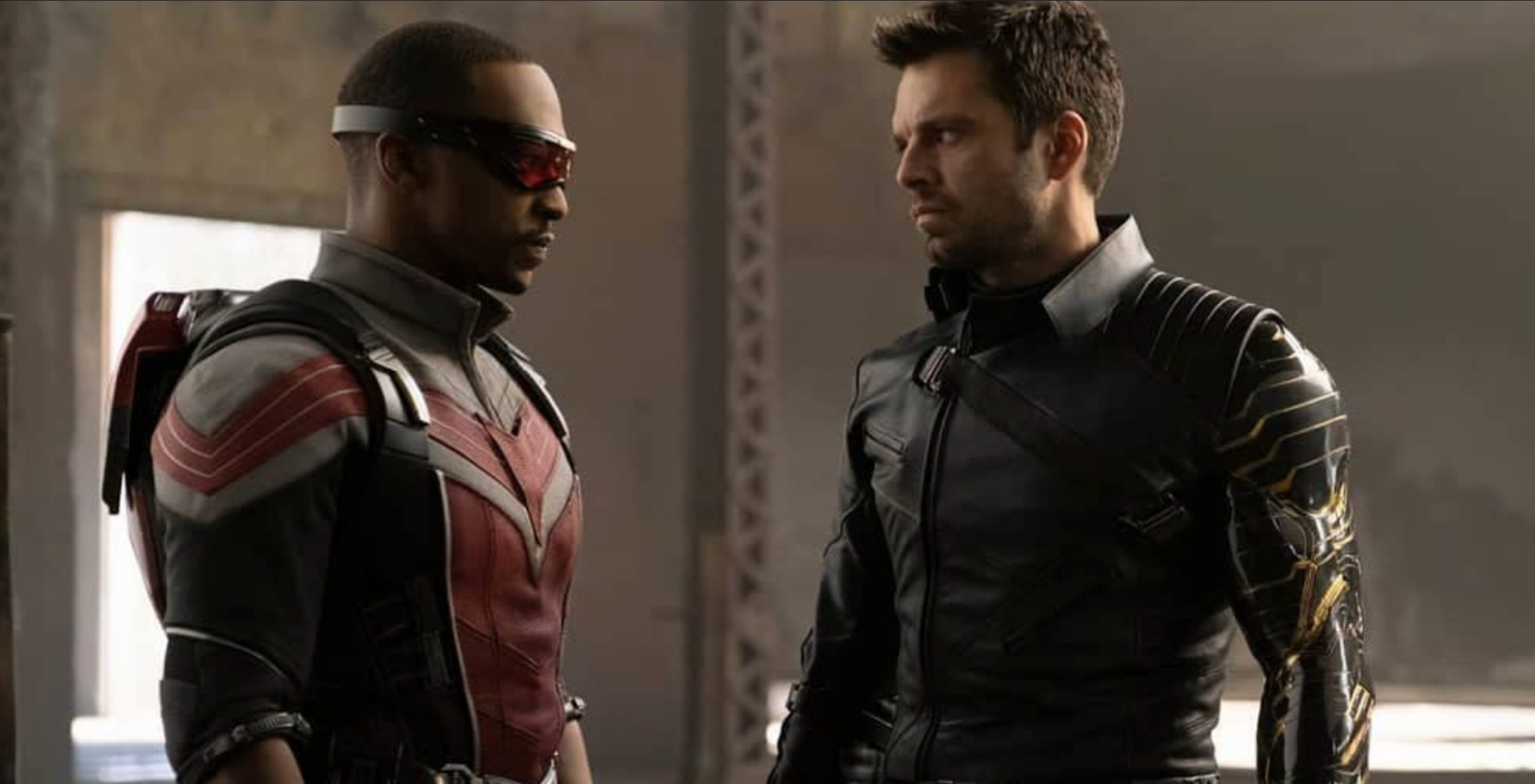Living in a Captain America-less world in ‘The Falcon and the Winter Soldier' and ‘Agent Carter’
The new Disney+ series is not the first Marvel series to deal with Steve Rogers' absence.

This post contains spoilers for The Falcon and the Winter Soldier.
Read our spoiler-free review here, and our spoiler-heavy one here.
Before Disney+ got in on the Marvel TV series action, ABC launched Agents of S.H.I.E.L.D. in 2013, followed by Agent Carter two years later. While WandaVision dipped its toe in a midcentury fantasy for a few episodes, Peggy Carter’s (Hayley Atwell) post-WWII setting is not an illusion. Rather, Peggy pushed her grief inward and used work as an outlet to avoid the pain of this loss. She is also contending with a world resisting women who joined the workforce during a time of conflict and are being pushed back into a homemaker role. The loss of Captain America (Chris Evans) is personal to Peggy; her relationship is with Steve Rogers and not the symbolic figurehead. To the world, his hero role is one that feels obsolete after the allies won the war. The opposite is true in the first episode of The Falcon and the Winter Soldier as the chaos caused by Thanos is a deep rupture that cannot be fixed overnight. Despite his retirement (not on the moon), Captain America’s image looms large to those closest to him, conspiracy theorists online, and the American government who are in desperate need of a powerful emblem.
“We’re going to explore where these two guys left off, with one big character missing — the prominent figure that brought them into each other’s lives. Where are they, and how are they coping with the world?” Sebastian Stan described the premise of The Falcon and the Winter Soldier in a recent New York Times interview. Even though 75 years separate Peggy from Sam (Anthony Mackie) and Bucky (Stan), the loss of this great love (whether romantic or platonic) is a foundation for both TV spin-offs born out of different MCU phases. The first line uttered in both shows is by Steve and this reinforces the role this character plays even when he is absent whether as a disembodied voice or using previous footage. In Agent Carter, this is accompanied by footage of his original goodbye to Peggy in Captain America: The First Avenger. Additional images from this movie are intercut with news that Howard Stark (Dominic Cooper) is a wanted man, which sets up Peggy’s first real mission after the end of the war.
MORE: How to watch every Marvel movie in order
ALSO: Check out Disney+ on Apple TV
Peggy’s striking red, white, and blue attire as she walks against a sea of dreary grey suits in the Agent Carter pilot serves several sartorial purposes. It is the color palette of the nation she hails from, but it is also a visual nod to her beau’s uniform. Refusing to take a step back, Peggy also continues the work she was hired to do in the SSR and stands her ground in bold shades. In the early episodes, Steve is referenced in a variety of overt and subtle ways. His picture is on the front page even though Howard is the one being sought — a classic tactic to sell more newspapers. Only a year has passed since Captain America flew into the ice, which explains his emphatic star power. Agent Carter pulls out the Project Rebirth file because it is pertinent to the case but it also serves as a reminder of her fondness for Steve before his transformation. Another flashback to the Stork Club dancing date Steve made reinforces this loss. It also makes sense to infuse shots from the movie as it had been four years since its theatrical release. Daredevil (which hit Netflix earlier that same year) only referenced events in The Avengers rather than directly weaving the stories together. It might read as heavy-handed to have this many clips from Captain America in the pilot about a character that isn’t Steve, but it is a reminder this link is more than cursory. Plus, Steve’s story is equally tied to Peggy’s, which his time travel adventure back to 1949 in Endgame proves.
The Falcon and the Winter Soldier isn’t quite this reliant in its use of movie imagery and one explainer might be down to the entire MCU library existing on the same platform. Agent Carter is part of this collection and hopefully, more viewers are discovering this underrated gem. Canceled after only two seasons on ABC, it is bittersweet to imagine how this show might have flourished if Disney+ existed in 2015.
Refreshers using past scenes is a useful narrative tool during the early stages of a new series when wooing viewers, but the story of Sam and Bucky is drawing on many Marvel movies rather than one. Additionally, unlike WandaVision that kicked off with a narrative baked in sitcom history, this series requires more than a deeper knowledge of these characters. This isn’t to say there aren’t lingering shots or conversations to signpost pertinent plot points. Substituting a clip package for an exposition-heavy scene is less clunky and the Smithsonian event is beneficial in not only highlighting how Sam sees the Captain America shield but also depicting a brief history of Cap. A catch-up with Colonel James “Rhodey” Rhodes (Don Cheadle) is an additional nod to the past that Sam references in his presentation. The speech is a mix of quips and sentiment that draws on the role of Captain America, a figure who was created during another conflict:
The latest updates, reviews and unmissable series to watch and more!
“It’s more about the man who propped it up. And he’s gone. So today we honor Steve’s legacy, but also? We look to the future. Thank you, Captain America. This belongs to you.”

The switch between using Steve and Captain America is also notable, reflecting the interwoven personal and professional aspects of this dynamic. Sam thinks he is gifting the Smithsonian with a historical artifact to be enjoyed by visitors to the Captain America exhibit. He can’t imagine anyone else holding this shield because he cannot extract Steve from Cap and vice versa. But to the US government, Captain America is as much a figurehead as the title of President and they use Sam’s donated gift (and his words) to prove this point. Talking to Rhodey while walking around the exhibit provides additional exposition, which includes a reminder of the other titular figure. Before Bucky became Winter Soldier he was James Buchanan “Bucky” Barnes and Steve’s OG bestie. The camera lingers on his picture to remind those who might have forgotten this important origin story nugget and just like Steve (before he traveled back in time), Bucky is also far older than his handsome face suggests.
Sam’s conversation with Rhodey also highlights his naivety regarding the Captain America position — despite having been imprisoned not that long ago. He remarks the world was without this hero when Steve was on ice for more than half a century. However, the landscape Peggy was operating in was not as broken as the post-snap chaos. New York in 1946 was far more stable even if nefarious figures were trying to destabilize society. Peggy is contending with men who see her as nothing more than a skirt and red lipstick who crack jokes about her being a “liaison” to Captain America. At work, she endures the cheap shots and uses their misogyny to get access to information. Meanwhile, Steve has been immortalized in “The Captain America Adventure Program,” which reduces Peggy to a damsel-in-distress cliché called Betty Carver. She gets no respect for the work she did in public so she resorts to doing it in the shadows. There are many ways to be a hero in the MCU and not just as the face of the superhero industrial complex.
Despite the 75 years that separate Agent Carter and The Falcon and the Winter Soldier, the parallels are striking in how the void left by Steve impacts Peggy, Sam, and Bucky in both work and private settings. One similarity between Bucky and Peggy is their desire to go it alone and thankfully they are both told how futile this will ultimately be. The absence of Steve in Bucky’s therapy session stands out and because he didn’t spend any time with Sam in the first episode we don’t know how this person who was a BFF to both of them will factor in. Regardless of whether Chris Evans makes an appearance, it is what these characters do without this guiding voice that matters.
- Why WandaVision's weekly release only helped the show
- What's the deal with Agatha Harkness?
- How WandaVision used the long pop culture history of the Salem Witch trials to its advantage
- We need to talk about Tyler Hayward
- WandaVision Finale Review
- The WandaVision Finale failed Monica Rambeau
- Wanda Maximoff's pain is finally given the attention it deserves in WandaVision
Emma Fraser spends most of her time writing about TV, fashion, and costume design; Dana Scully is the reason she loves a pantsuit. Words can also be found at Vulture, Elle, Primetimer, Collider, Little White Lies, Observer, and Girls on Tops. Emma has a Master’s in Film and Television, started a (defunct) blog that mainly focused on Mad Men in 2010, and has been getting paid to write about TV since 2015. It goes back way further as she got her big start making observations in her diary about My So-Called Life’s Angela Chase (and her style) at 14.


